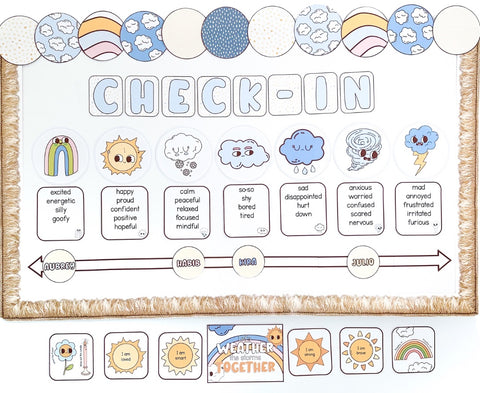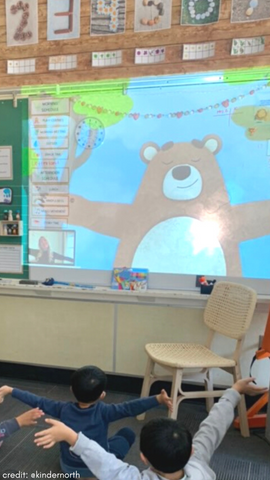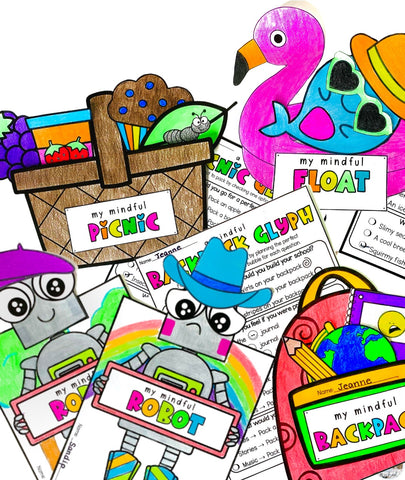Picture this: a classroom buzzing with excitement, where students are not only absorbing information but also thriving in a space of calm and focus. If this sounds like a pipe dream, then hold onto your Bluey backpacks, because we're about to dive into the magical world of mindfulness in the classroom.

In today's fast-paced world, where distractions lurk around every corner and student-directed classrooms are king, teaching mindfulness isn't just a nice-to-have—it's a game-changer.
In this post, I will walk you through the top benefits of mindfulness for students and then show you 6 simple, actionable ways of blending it seamlessly into your social emotional learning program.
Reduce Stress and Anxiety
When we aren’t feeling our best, we can’t do our best, and according to the results of Mindful Pre-Assessment showcased in a Northwestern article, 73.7% of students strongly agreed that they are often anxious and stressed. Incorporating mindfulness into our elementary programs is non-negotiable in order to help our children establish strong, grounded roots before they are able to grow socially, emotionally and academically.
Improve Self-Regulation and Self-Awareness
Mindfulness can also help our children regulate their attention and emotions. According to an article from the American Psychologist Association, it is believed to be so effective that it can even alter the pathways in the associated structures of the brain.
Many of us teachers and couselors aim to re-create the most aesthetic and welcoming classrooms that flood our Instagram and Tiktok feeds, but to its core, a truly safe and welcoming learning environment starts from within. Mindfulness encourages our students to pause long enough to listen to their bodies, and equips them with the vocabulary needed to share how they’re feeling and why. As this self-awareness grows, so too does their ability to empathize with their classmates and the world around them.
Perform Better Academically
Mindfulness supports attention and focus by acting like a spotlight- it guides it back to the present moment, helping us stay engaged and on task. With continued practice, our students are able to build their stamina and retain information at a higher level. With greater attention to detail, comes a burning curiosity that fuels creative thinking and problem-solving skills.
Build Self-Esteem
When we practice mindfulness, we become more aware of our thoughts and feelings without judgment. This non-judgmental awareness allows us to observe our inner dialogue with kindness and compassion, rather than harsh self-criticism. Over time, this gentle approach to self-reflection helps us cultivate a positive self-image and boost our self-esteem.
Additionally, mindfulness teaches us to accept ourselves as we are, fabulous flaws and all. By intentionally creating space to gush about our successes and speaking openly about our own insecurities as a class, we learn to embrace our uniqueness and appreciate our strengths. This acceptance fosters a sense of inner peace and contentment, which forms the fertile soil from which lifelong, healthy relationship skills thrive.
Moreover, mindfulness empowers us to disengage from negative thought patterns and destructive self-talk. By observing our thoughts from a distance, we gain perspective and realize that we are not defined by intrusive thoughts.
Ways to Implement Mindfulness
So, where to begin? Here are 6 concrete, fun ways of integrating mindfulness into your primary programs right away.
Check In
Checking in is the single most important (and simplest) investment you will make in your day-to-day. We cannot make assumptions that our students are coming to school primed and ready to learn. Like us, children have mental loads that they carry, and it is our job to create space to help them unpack and acknowledge. Try these alongside our attention grabbers with heart to co-regulate when connection-seeking behaviors and volumes start to rise.
Self-Directed Stations
I'm a huge advocate of soft entry into the classroom because mornings are such a beautiful opportunity to set the tone for the day. I spread out a variety of centers that students can explore that each relate to team-building, conscious deep breathing, yoga stretches or positive self talk. The impact of having students physically and emotionally reset before a day of learning has been instrumental to morale, academic stamina and relationship-building.
Bite-size Video Breaks
These short, no-fuss YouTube videos are the perfect way to embed mindful minutes into your circle time, morning meeting, lunchtime or transitions back into the classroom from high-octane periods (e.g., recess or Phys Ed).
Crafts
Art therapy provides a safe and expressive outlet for exploring emotions that may be difficult to verbalize. Through the creative process, our primary children can assign their inner thoughts and feelings to colors and concrete shapes, allowing for greater self-awareness and insight into their emotional landscape. It promotes relaxation and stress reduction and encourages self-expression and empowerment. Mindful glyphs, like the ones pictured, support individuality and equalize the artistic process so that children of many age groups can participate and use visualization to help them through anxiety and other big emotions.
Coloring has a long list of benefits, including the ability to shut off any nagging worries, conflicts or burdens, and to open our minds up to clarity and calm. I choose my coloring pages based on the developmental and social skills needs of the group which I’m supporting.
Small Group Instruction
Working with smaller groups for even 15 minutes at a time, whether it be during Lunch Bunch or integrating it into your soft start morning or literacy blocks, can have a significant long-term impact on community morale and social skills development, which translates directly into a classroom management win for us. This mindfulness unit blends emotional regulation, movement and hands-on learning through 8 accessible, interactive lessons to support mindful living.
Visualization
These mini virtual field trips take a journey through ordinary places to discover extraordinary things. This bundle of digital mindfulness adventures includes hidden friends, interesting sound effects and unexpected calm that can help model for our students mindful principles that they can easily embed into their day-to-day as well.









